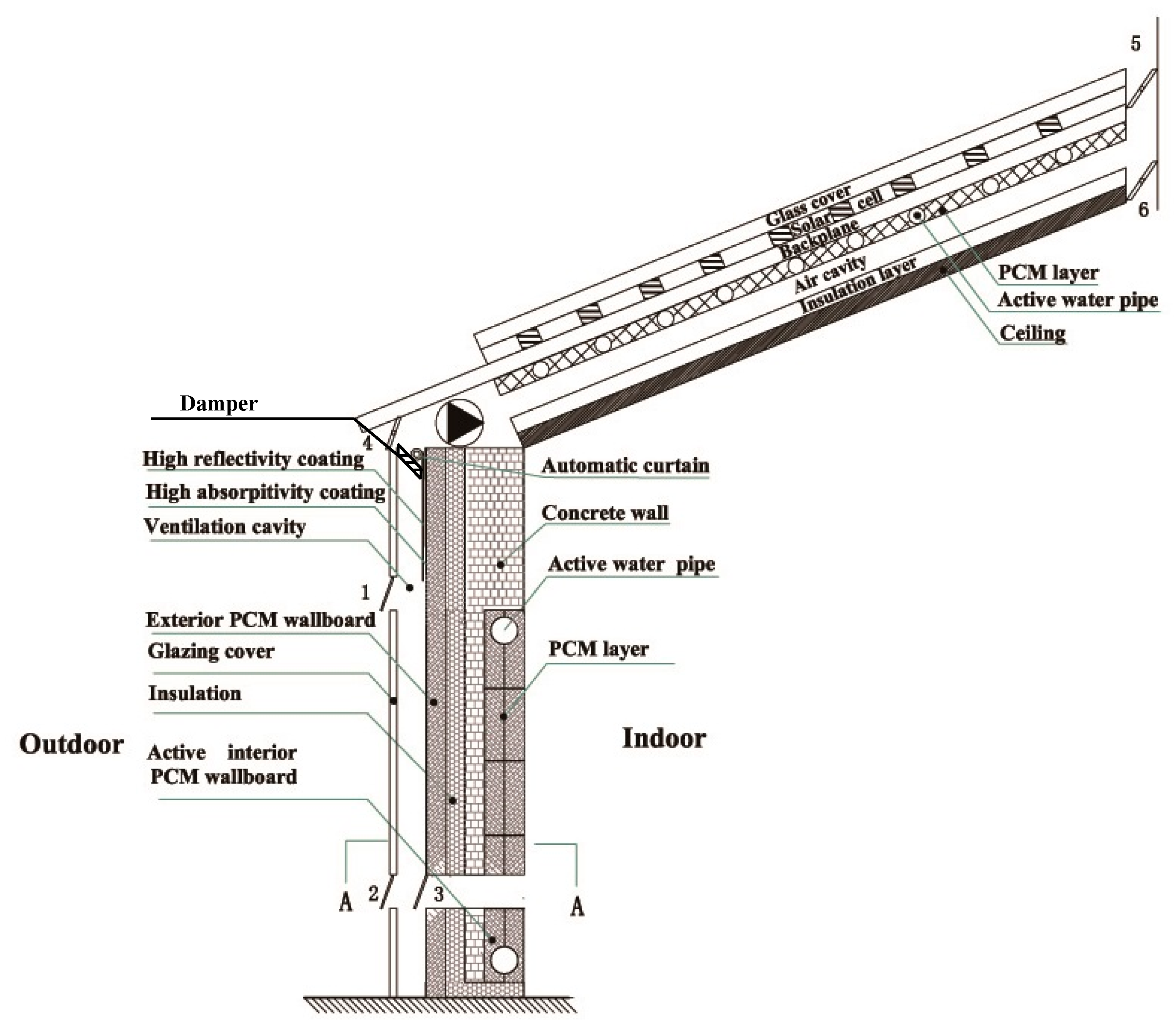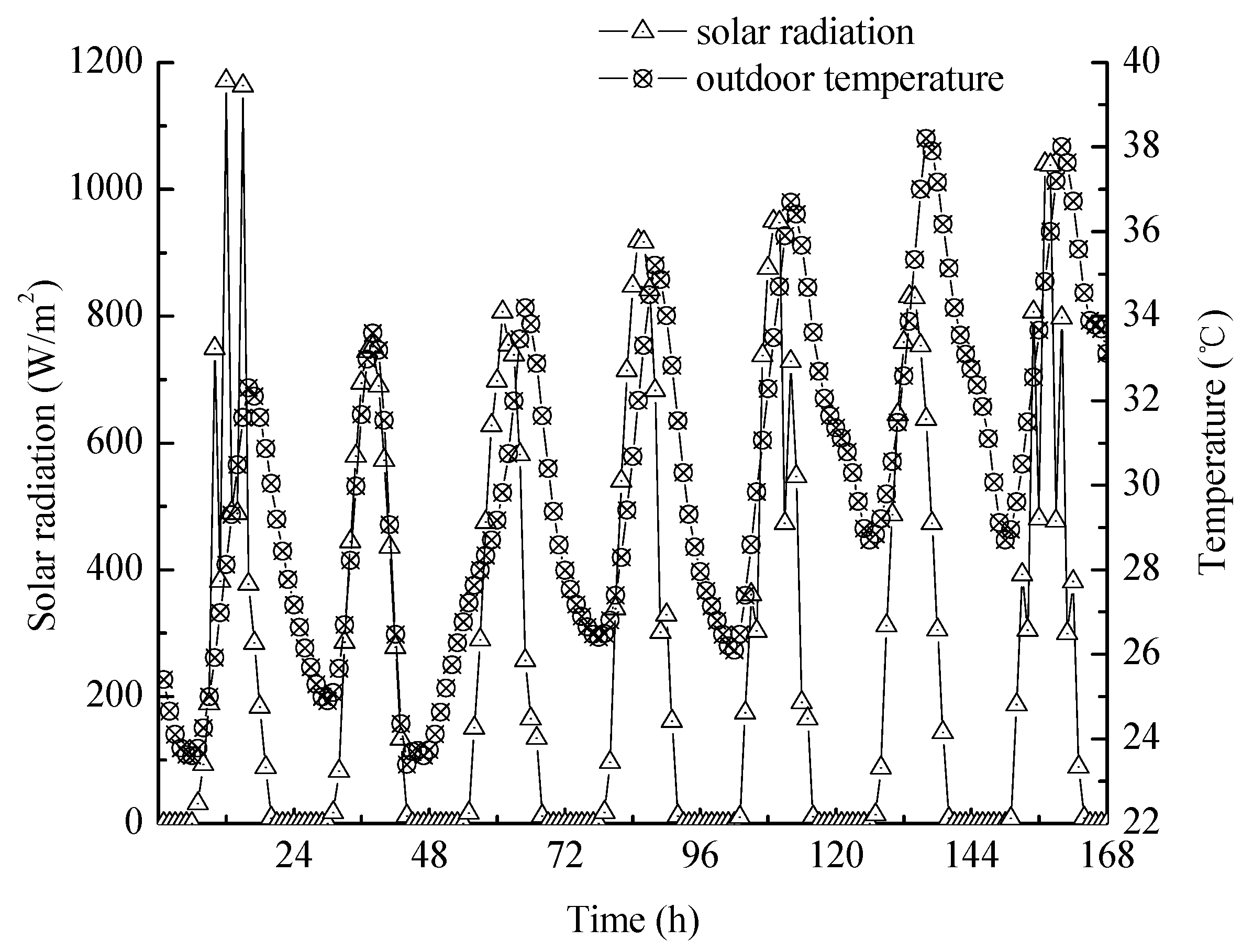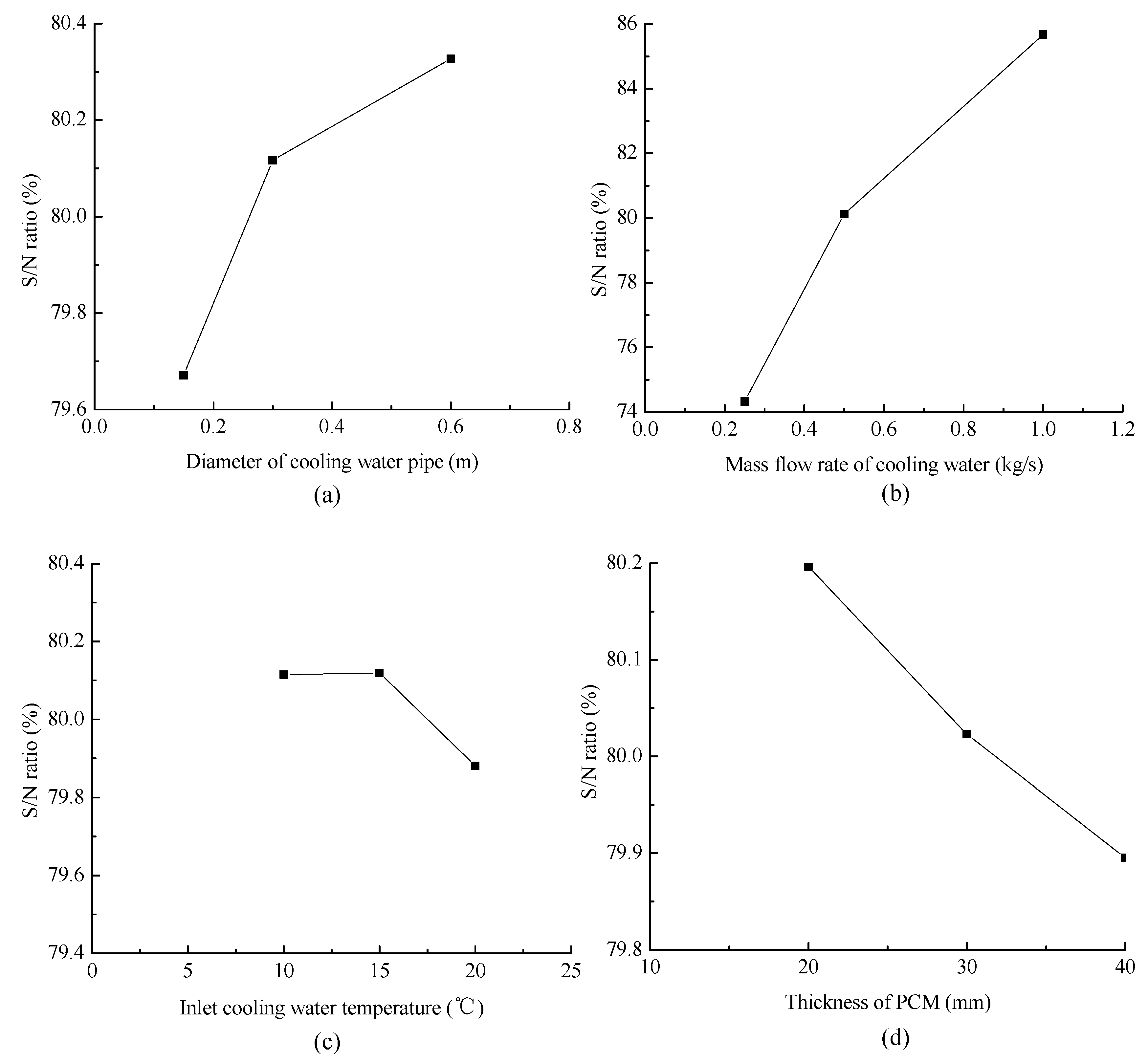1. Introduction
Building energy consumption has been continuously increasing over the past several decades, accounting for more than 40% of the total energy consumption in numerous International Energy Agency member countries [
1]. Currently, increasing the penetration of the renewable energy for domestic usage has widely attracted an increasing attention [
2,
3,
4,
5,
6,
7]. Renewable systems for buildings’ application can be installed on-site or nearby to reduce energy loss during energy generation, transmission and distribution processes. Meanwhile, the on-site renewable system for the buildings’ usage can reduce the total emission of carbon oxides, nitrogen oxides and sulfur oxides [
8,
9], mitigate the utility grid pressure [
10] and thus generate economic impetus [
11]. After being implemented with renewable system, the role of buildings will be changed from merely energy consumer to the energy prosumer [
12,
13,
14]. The inherent characteristics of renewable energy, that is, dispersion, intermittency, instability and uncontrollability, result in low correspondence with the stochastic residential load. Numerous studies concentrate on the optimal configuration of the energy management system and the optimal energy control strategy to improve the self-consumption capacity of the buildings [
15,
16].
As a typical renewable energy generation technology, the photovoltaic (PV) cell has widely attracted the public attention, as it is able to convert solar radiation into electrical energy because the electrons are released by semiconducting materials after absorbing photons from sunlight. The problem is that, only a relatively small proportion of solar radiation (around 10−20%) [
17] can be effectively converted into electricity, while the rest would be discarded as heat. The released heat increases the PV temperature and reduces the photovoltaic efficiency [
18]. To meet residents’ thermal and electrical demand in different types of buildings, the hybrid photovoltaic/thermal (PV/T) system is regarded as one of the most effective technologies as it is able to convert solar radiation to both heat and electricity with little heat discarded as PV does. PV/T collector can be generally categorized into air−based PV/T system and water−based PV/T system depending on the cooling medium. Shahsavar et al. [
19] experimentally and numerically studied both thermal and photovoltaic performances of a direct−coupled PV/T air collector, in which a thin aluminum sheet suspended in the middle of air channel was used. The result shows that, with the objective to maximize the electrical efficiency, there was an optimal value of the air flow rate depending on the number of fans. Slimani et al. [
20] conducted a comparative study within four configurations, that is, photovoltaic module (PV−I), conventional hybrid solar air collector (PV/T−II), glazed hybrid solar air collector (PV/T−III) and glazed double−pass hybrid solar air collector (PV/T−IV). According to the results, the daily average overall energy efficiency (including both thermal and photovoltaic efficiencies) achieved its maximum value of 74% in the PV/T−IV, sequentially followed by the PV/T−III of 69.47%, the PV/T−II of 51.02% and then the PV/T−I of 29.63%. As for the water−based PV/T system, Yazdanifard numerically evaluated both total energy and exergy efficiencies of a water−based flat plate photovoltaic/thermal system. Afterwards, both the mass flow rate and the number of pipe were optimized in terms of maximizing both total energy and exergy efficiency [
21]. In addition, Tse et al. [
22] demonstrated the advantages of the liquid−based PV/T system regarding energy and economic savings. They concluded that integrating PV/T technologies into office buildings would realize low carbon emissions in the subtropical climate region.
The inherent characteristic of the discrepancy between the renewable generation and the energy demand proposes the challenge to efficiently utilize the renewable energy. Thermal energy storage via phase change material (PCM) is able to compensate the intermittency and instability of the renewable generation via its high energy storage density [
23]. In addition to being implemented with the thermal energy storage tanks and the building façade [
24], PCM being integrated with PV system would also be a promising solution in terms of mitigating the overheating of PV cell as PCM is able to absorb the heat via phase transition at nearly constant temperature. In the academic literature, numerous studies mainly focus on the thermal performance of PV system [
25], the overall efficiency [
26] and the net overall solar efficiency [
27] of PV/T system integrated with PCM. Kibria et al. [
25] developed a transient one−dimensional energy balance model of a photovoltaic module integrated with PCM. According to their results, an increasing ratio of thermal performance at 5% can be observed as the PCM was effective in limiting the temperature rise of PV devices. Su et al. [
26] have conducted the comparative analysis on a hybrid PV/T system integrated with PCM. They concluded that, compared to the ‘no PCM’ mode, the overall efficiency of the hybrid PV/T system in the ‘upper PCM’ mode could be improved by over 10.7%. Qiu et al. [
27] have conducted an experimental study on a novel micro−encapsulated Phase Change Material (MPCM) slurry based PV/T system. According to their results, a net overall solar efficiency of 80.8–83.9% can be realized under the recommended operational conditions: MPCM slurry weight concentration of 10%, slurry Reynolds number of 3000 and solar radiation of 500–700 W/m
2.
The energy performance optimization of the PCM integrated PV/T system has also attracted an increasing attention in the academic world. The PCM integrated PV/T system is complicated as it involves different energy forms, diversified conversions and hybrid thermal storages, together with multi variables. To optimize the geometric and operational parameters of the system with numerous variables, Taguchi method has been extensively used for the trial experiments design and the determination of optimal combination levels of variables, as it is robust and efficient in addressing the multi−dimensional optimization problem [
28]. In addition, several variables can be paid less attention or even ignored if the percentage contribution of each variable to the objective is low. This will reduce the redundancy of the multi−dimensional optimization problem. Lin et al. [
29] concluded that Coefficients of Thermal Performance Enhancement (CTPE) could be increased to 70.2% in the most optimal combination case after adopting the Taguchi method. To address the problems with continuous and discrete variables, they [
30] adopted the Taguchi−Fibonacci search method to maximize the Signal−to−Noise (S/N) ratio of CTPE of buildings. According to their results, the CTPE of the house was improved from 45.54% to 72.22% in comparison with the case without adopting the optimization methodology. Xie et al. [
31] have also identified the optimal combination of design parameters of an ice thermal storage system with a thin layer ring using the Taguchi method. The reproducibility of the results was verified by the analytical results.
However, there are few studies concentrating on evaluating both thermal and photovoltaic performances of a PCM integrated PV/T collector with hybrid active cooling techniques. Furthermore, the Taguchi method has hardly been used to optimize the geometric and operational parameters of the hybrid system involving with different energy forms, diversified conversions and hybrid thermal storages. In this study, the equivalent overall output energy was proposed as the objective of the hybrid system involving with diversified energy conversions and hybrid thermal storages. The ultimate objective is to maximize the S/N ratio of the equivalent overall output energy and identify the optimal combination of both geometric and operational parameters to provide the technical guidance to the engineers. To realize the research objective, the first step is to develop an experimentally validated numerical model for the parametrical analysis. The investigated geometric and operational parameters include the diameter of active cooling water pipe, the mass flow rate and the inlet temperature of active cooling water and the thickness of PCM layer. Afterwards, Taguchi method is used to form a matrix of experiments following the orthogonal array. The numerical experiments were thereafter conducted for the comparative analysis. Finally, the Analysis of Variance is used to quantitatively identify the percentage of contribution of each factor to the overall energy performance of the hybrid system.
2. System Description
A hybrid system, which is composed of a PCM integrated ventilated Trombe wall and a PCM integrated PV/T panel, is proposed and analyzed as shown in
Figure 1. There is an automatic air damper between the Vents 1 and 4. The automatic air damper is off during the summer daytime to avoid the hot air flowing into the PV air cavity, whereas the automatic air damper is on to form an air flow path during the night time. In the PV/T−PCM system, the photovoltaic/thermal panel is constituted of glass cover, solar cell, backplane, PCM layer with cooling water pipes, air cavity and insulation layer. The active cooling water is regarded as the working fluid to extract heat from the solar cell to provide hot water for the domestic usage. As mentioned in the above literature review [
20,
21], thermal and photovoltaic performances of the PV/T system are highly dependent on the mass flow rate of the cooling water, the temperature of cooling water, the diameter of the active cooling water pipes and the thickness of PCM layer. These parameters are quantitatively investigated in this study. Meanwhile, to avoid the moisture condensation of the PCMs−VTW radiant cooling system, active cooling water is supplied with a relatively high temperature of 20 °C, which is higher than traditional chilled water in AHU cooling coil (7 °C) or space cooling (15 °C). The availability of PCM contributes to shifting cooling energy from the off−peak period to the peak period for the domestic usage.
The motivation for integrating the Trombe wall is to improve the equivalent overall output energy with different technical solutions, such as the natural ventilation of the Trombe wall to resist the heat gain through the building envelope during the daytime and to store the natural cooling energy during the nighttime. Moreover, the radiative cooling can recover the heat energy for the domestic hot water applications. The advantages for coupling a Trombe Wall with the PV/T-PCM system can be summarized as follows:
- 1)
Cooling the supply air (consisting both outdoor fresh air and indoor return air) with the exterior PCM wallboard and re-cooling the supply air with the active PCM layer in the PV/T system. The supply air will be firstly cooled by the natural cooling energy in the exterior PCM wallboard. Afterwards, the cooling energy provided by the PV/T system for handling the supply air will be reduced. In other words, the implementation of the exterior PCM wallboard can enhance the cooling energy provided by the active cooling water in the PV/T system for cooling the PV panels.
- 2)
Increasing the cooling effect of the PV/T system via the heat transfer between the cooled supply air and the PCM in the PV/T system, when the stored cooling energy in the exterior PCM wallboard is released as shown in
Figure 2b.
- 3)
The interior PCM wallboard can also reduce the cooling energy consumption of the active PV system for handling the supply air, as the radiative cooling can partially cover the building cooling load. In other words, the implementation of the interior PCM wallboard can also enhance the cooling energy provided by the active cooling water in the PV/T system for cooling the PV panels.
4. Taguchi Optimization Method
Section 3 indicates that the increase of the diameter of active cooling water pipe, the mass flow rate of the active cooling water and the thickness of PCM can improve equivalent overall output energy (Q
E), whereas the increase of the inlet temperature of active cooling water shows a completely contrary trend. However, it exclusively investigates the influence of each separate variable on the system performance without comprehensively considering the effect of different combinations of these parameters on the energy performance of the PV/T-PCM system. Taguchi optimization method is an experimental optimization technique that adopts the standard orthogonal arrays in matrix form of experiments for the multi-dimensional optimization in the system design [
28,
44,
45]. Multiple variables (factors in Taguchi method) and several values of these variables (factor levels) are arranged according to standard orthogonal arrays, enabling dramatic decrease in full-factorial trial experiments. Comprehensive numerical evaluation of system performance using Taguchi optimization method is time-saving and economically beneficial. Therefore, the Taguchi optimization method is adopted here to systematically and comprehensively evaluate the effect of all performance-related variables on the equivalent overall output energy (Q
E) in the PV/T-PCM system.
Generally, by adopting Taguchi method, the following steps should be taken to conduct the parametrical study in the PV/T-PCM system. The optimal combination of each factor and the corresponding level will be thereafter identified.
- 1)
Definite the ultimate purpose and evaluate the overall performance. Meanwhile, identify evaluating index of the system;
- 2)
Determine the number of corresponding levels for parameters (factors) and possible interactions between parameters;
- 3)
Select the suitable orthogonal array and assign parameters with the orthogonal array;
- 4)
Conduct trial experiments according to the orthogonal array;
- 5)
Analysis of results: S/N, ANOVA and Response Table;
- 6)
Select the optimal levels of each parameter;
- 7)
Validate the optimal combination of parameters by conducting confirmation experiment.
As the principle objective of this research is to identify the optimal combination of all energy related variables to improve overall energy performance of the PV/T-PCM system, the signal to noise (S/N) ratio has been extensively treated as the objective function in the experimental design. Generally, three kinds of performance characteristic are selected in the analysis, including the−smaller−the−better, the−larger−the−better and the−nominal−the−better. Correspondingly, three kinds of S/N ratios are available depending on the performance characteristic chosen in the optimization problem [
35]:
where
is the jth observed objective value from Taguchi trial experiment; s is the variance; n is the number of the observations in a trial experiment.
This research is to identify the optimal combination and corresponding values in energy-related variables such as the diameter of active cooling water pipe, the mass flow rate and the inlet temperature of active cooling water and the thickness of PCM. The−higher−the−better S/N ratio is adopted for the analysis as shown in the Equation (50).














